- 1School of Ecology and Nature Conservation, Institute of Microbiology, Beijing Forestry University, Beijing, China
- 2Faculty of Agronomy and Life Sciences, Zhaotong University, Zhaotong, China
- 3Department of Botany, Hungarian University of Agriculture and Life Sciences, Budapest, Hungary
Panellus is an Agaricales genus with both lamellate and poroid hymenophore. The poroid species are readily overlooked because of their tiny basidiocarps. The Chinese samples of poroid Panellus are studied, and five species, namely Panellus alpinus, Panellus crassiporus, Panellus longistipitatus, Panellus minutissimus, and Panellus palmicola are described as new species based on morphology and molecular phylogenetic analyses inferred from an nrITS dataset and a multi-gene dataset (nrITS + nrLSU + mtSSU + nrSSU + tef1). Panellus alpinus is characterized by its round to ellipsoid pores measuring 4–6 per mm and oblong ellipsoid basidiospores measuring 4.8–6 μm × 2.8–3.6 μm; P. crassiporus differs from other poroid species in the genus by the irregular pores with thick dissepiments and globose basidiospores measuring 8–9.8 μm × 6.9–8 μm; P. longistipitatus is distinguished by its long stipes, pyriform cheilocystidia, and broadly ellipsoid to subglobose basidiospores measuring 7–9.8 μm × 5–7 μm; P. minutissimus is characterized by its tiny and gelatinous basidiocarps, 5–20 pores per basidiocarp, and ellipsoid basidiospores measuring 6–8 μm × 3.2–4.2 μm; P. palmicola is characterized by its round pores measuring 2–4 per mm, the presence of acerose basidioles, and globose basidiospores measuring 7–9.5 μm × 6.2–8.2 μm. An identification key to 20 poroid species of Panellus is provided.
Introduction
The genus Panellus P. Karst. (Mycenaceae, Agaricales), typified by Panellus stipticus (Bull.) P. Karst., was established by Karsten (1879). It is characterized by gelatinous to soft corky, pileate to stipitate basidiocarps with both lamellate and poroid hymenophore, thick-walled tramal hyphae, dichophysial hyphae, ellipsoid, ovoid to globose basidiospores, and as causing a white rot (Burdsall and Miller, 1975, 1978; Libonati-Barnes and Redhead, 1984; Corner, 1986; Chang, 1996; Zhang and Dai, 2021).
The taxonomic history of Panellus is somewhat ambiguous. In previous studies, the hymenophore structure (e.g., lamella and pores) was considered as an important taxonomic feature on generic level. Later, taxonomists found some intermediate species, such as Panellus pusillus (Pers. ex Lév.) Burds. and O. K. Mill. and Panellus intermedius Corner with poroid to lamellate hymenophore (Singer, 1953; Corner, 1986). Accordingly, Burdsall and Miller (1975) treated Dictyopanus Pat., a poroid mushroom and a subgenus of Panellus, and all species of Dictyopanus transferred to Panellus.
Panellus has been extensively studied in the Americas and Europe. However, previous studies mainly focused on lamellate species and only a few reports were provided on poroid species (Earle, 1909; Macrae, 1937; Singer, 1962; Miller, 1970). So far, Corner (1986) reported 13 poroid species of Panellus, including eight new species. Johnston et al. (2006) transferred Favolaschia minima (Jungh.) Kuntze to Panellus based on morphological characteristics and molecular analyses. Zhang and Dai (2021) reported two new poroid species of Panellus based on morphology and phylogeny. Currently, more than 50 species are accepted in Panellus (Wijayawardene et al., 2022), among them 15 have poroid hymenophore.
This study aims to explore the diversity and phylogeny of Panellus, and five new poroid species from China are confirmed to be members of the genus. Currently, the main morphological characteristics of 20 poroid species of Panellus are outlined, and an identification key to these species of Panellus is provided.
Materials and Methods
Morphological Studies
The studied specimens are deposited in the herbarium of the Institute of Microbiology, Beijing Forestry University (BJFC). Morphological descriptions are based on field notes and voucher specimens. Microscopic analyses follow Cui et al. (2019) at a magnification of 1,000× using a Nikon Eclipse 80i microscope (Tokyo, Japan) with phase contrast illumination. In the description, the following abbreviations are used: KOH = 5% potassium hydroxide; IKI = Melzer’s reagent, IKI+ = amyloid; CB = Cotton Blue, CB– = acyanophilous in Cotton Blue; L = arithmetic average of basidiospores length, W = arithmetic average of basidiospores width, Q = L/W ratios, (n = x/y) = x measurements of basidiospores from y specimens. Color terms are from Royal Botanic Garden Edinburgh (1969) and Petersen (1996).
Molecular Studies and Phylogenetic Analysis
A cetyltrimethylammonium bromide (CTAB) rapid plant genome extraction kit (Aidlab Biotechnologies Co., Ltd., Beijing, China) was used to extract DNA (Sun et al., 2020; Liu et al., 2021). The following primer pairs were used to amplify the non-coding genes: ITS5 (5′-GGA AGT AAA AGT CGT AAC AAG G-3′) and ITS4 (5′-TCC TCC GCT TAT TGATAT GC-3′) for the internal transcribed spacer regions (nrITS; White et al., 1990); LR0R (5′-ACC CGC TGA ACT TAA GC-3′) and LR7 (5′-TAC TAC CAC CAA GAT CT-3′) for nuclear large subunit rDNA (nrLSU; Vilgalys and Hester, 1990); MS1 (5′-CAG CAG TCA AGA ATA TTA GTC AAT G-3′) and MS2 (5′-GCG GAT TAT CGA ATT AAA TAA C-3′) for the small subunit mitochondrial rRNA gene (mtSSU); NS1 (5′-GTA GTC ATA TGC TTG TCT C-3′) and NS4 (5′-CTT CCG TCA ATT CCT TTA AG-3′) for the small subunit of nuclear ribosomal RNA gene (nrSSU); as well as protein coding gene: 983F (5′-GCY CCY GGH CAY CGT CAY TTY AT-3′) and 1567R (5′-ACH GTR CCR ATA CCA CCS ATC TT-3′) for translation elongation factor 1α (tef1).
The PCR cycling schedules for different DNA sequences of nrITS, nrLSU, mtSSU, nrSSU, and tef1 genes used in this study followed those used in Wang et al. (2021) and Zhou et al. (2021). The PCR products were purified and sequenced at the Beijing Genomics Institute (BGI), China with the same primers, and the newly generated sequences were deposited in the GenBank. The sequences generated in this study were aligned with additional sequences downloaded from GenBank (Table 1) using Clustal X (Thompson et al., 1997) and manually adjusted in BioEdit (Hall, 1999).
In this study, nuclear ribosomal RNA genes were used to determine the phylogenetic positions of new species. The sequence alignment was deposited at TreeBase (submission ID 29605). Sequences of Hemimycena mairei (E-J. Gilbert) Singer were used as outgroup (Vu et al., 2018).
Maximum parsimony (MP), maximum likelihood (ML), and Bayesian inference (BI) were employed to perform the phylogenetic analysis of the two aligned datasets. MP topology and bootstrap (BT) values obtained from 1,000 replicates were computed in PAUP* version 4.0b10 (Swofford, 2002). All characters were equally weighted, and the gaps were treated as missing data. Trees were inferred using the heuristic search option with tree-bisection reconnection (TBR) branch swapping and 1,000 random sequence additions. Max-trees were set to 5000, branches of zero length were collapsed, and all parsimonious trees were saved. Clade robustness was assessed by a BT analysis with 1,000 replicates (Felsenstein, 1985). Descriptive tree statistics, such as tree length (TL), consistency index (CI), retention index (RI), rescaled consistency index (RC), and homoplasy index (HI) were calculated for each maximum parsimonious tree (MPT) generated.
RAxML 7.2.8 was used to construct ML trees for both datasets with the GTR + I + G model of site substitution, including the estimation of gamma-distributed rate heterogeneity and a proportion of invariant sites (Stamatakis, 2006). The branch support was evaluated with a bootstrapping method of 1,000 replicates (Hillis and Bull, 1993).
The BI was conducted with MrBayes 3.2.6 in two independent runs, each of which had four chains for 10 million generations and started from random trees (Ronquist and Huelsenbeck, 2003). Trees were sampled every 1000th generation. The first 25% of the sampled trees were discarded as burn-in and the remaining ones were used to reconstruct a majority rule consensus and calculate Bayesian posterior probabilities (BPPs) of the clades.
Phylogenetic trees were visualized using Treeview (Page, 1996). Branches that received BT support for MP (≥75%), ML (≥75%), and BPPs (≥0.95) were considered as significantly supported.
Results
Phylogeny
The nrITS-based phylogeny included nrITS sequences from 38 fungal collections representing 13 species. The dataset had an aligned length of 665 characters, of which 372 characters are constant, 61 are variable and parsimony-uninformative, and 232 are parsimony-informative. MP analysis yielded two trees (TL = 546, CI = 0.771, RI = 0.921, RC = 0.710, HI = 0.229). The best model for the nrITS sequences dataset estimated and applied in the BI was GTR + I + G. BI resulted in a similar topology with an average standard deviation of split frequencies = 0.007304 to MP analysis, and thus only the MP tree is provided.
The combined 5-gene (nrITS + nrLSU + mtSSU + nrSSU + tef1) sequence dataset from 38 fungal specimens representing 13 taxa did not show any conflicts in tree topology for the reciprocal bootstrap trees, which allowed us to combine them (p > 0.01). The dataset had an aligned length of 3,682 characters, of which 2,932 characters are constant, 266 are variable and parsimony-uninformative, and 484 are parsimony-informative. MP analysis yielded three trees (TL = 1120, CI = 0.846, RI = 0.918, RC = 0.777, HI = 0.154). The best model for the combined nrITS + nrLSU + mtSSU + nrSSU + tef1 dataset estimated and applied in the Bayesian analysis was GTR + I + G. Bayesian analysis resulted in a similar topology with an average standard deviation of split frequencies = 0.004519 to MP analysis, and thus only the MP tree is provided. Both BT values (≥75%) and BPP values (≥0.95) are shown at the nodes (Figures 1, 2).
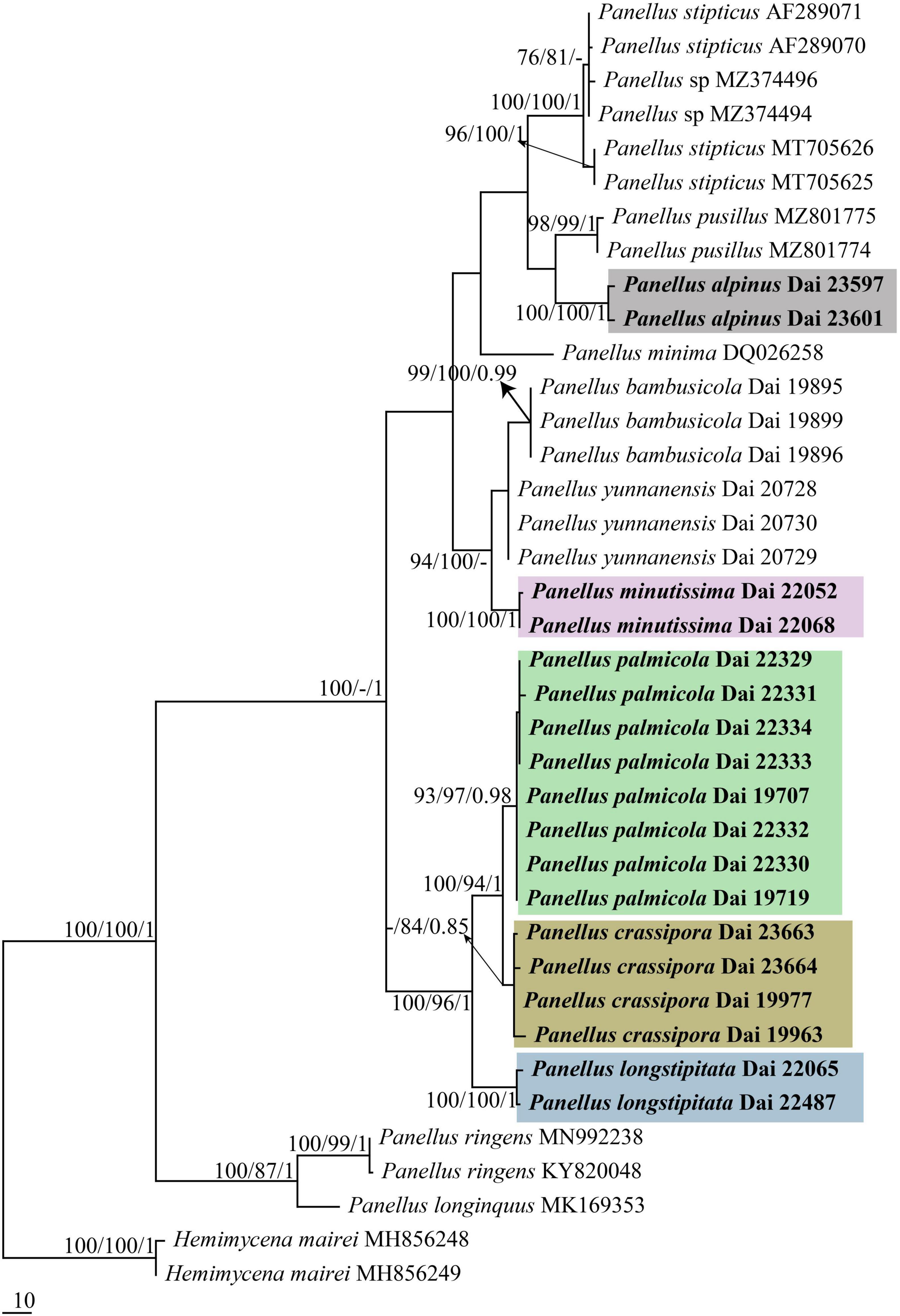
Figure 1. Maximum parsimony (MP) tree illustrating the phylogeny of Panellus based on nrITS dataset. Branches are labeled with parsimony bootstrap values (MP/ML) higher than 75%, and Bayesian posterior probabilities (BPPs) more than 0.95. The five colors represent the five new species in this paper, respectively.
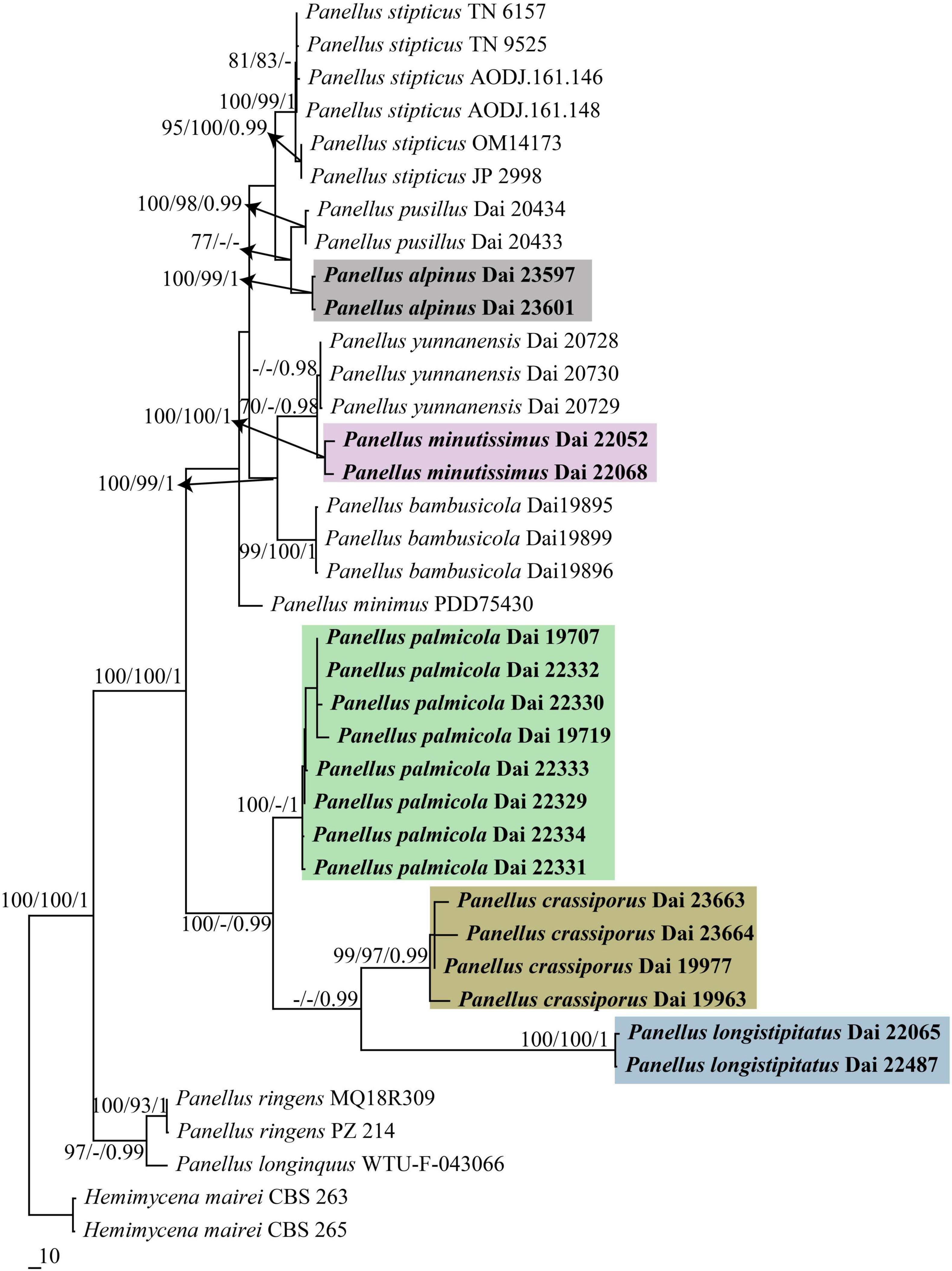
Figure 2. Maximum parsimony (MP) tree illustrating the phylogeny of Panellus based on combined 5-gene (nrITS + nrLSU + mtSSU + nrSSU + tef1) dataset. Branches are labeled with parsimony bootstrap values (MP/ML) higher than 75% and Bayesian posterior probabilities (BPPs) more than 0.95. The five colors represent the five new species in this paper, respectively.
In both nrITS and nrITS + nrLSU + mtSSU + nrSSU + tef1 based phylogenies (Figures 1, 2), five new well-supported lineages were formed. Among them, two specimens (Dai 23597 and Dai 23601) from Tibet formed a well-supported lineage (100/100/1 in Figure 1, 100/99/1 in Figure 2), named Panellus alpinus, sister to P. pusillus. Two specimens (Dai 22052 and Dai 22068) formed a well-supported lineage, named P. minutissimus (100/100/1 in Figures 1, 2), and is closely related to Panellus bambusicola Q. Y. Zhang and Y. C. Dai and Panellus yunnanensis Q. Y. Zhang and Y. C. Dai. In addition, another 14 samples formed three distinct lineages nested in Panellus, and they are named P. crassiporus, P. longistipitatus, and P. palmicola, respectively.
Taxonomy
Panellus alpinus Q. Y. Zhang, F. Wu, and Y. C. Dai, sp. nov., Figures 3A, 4A, 5.
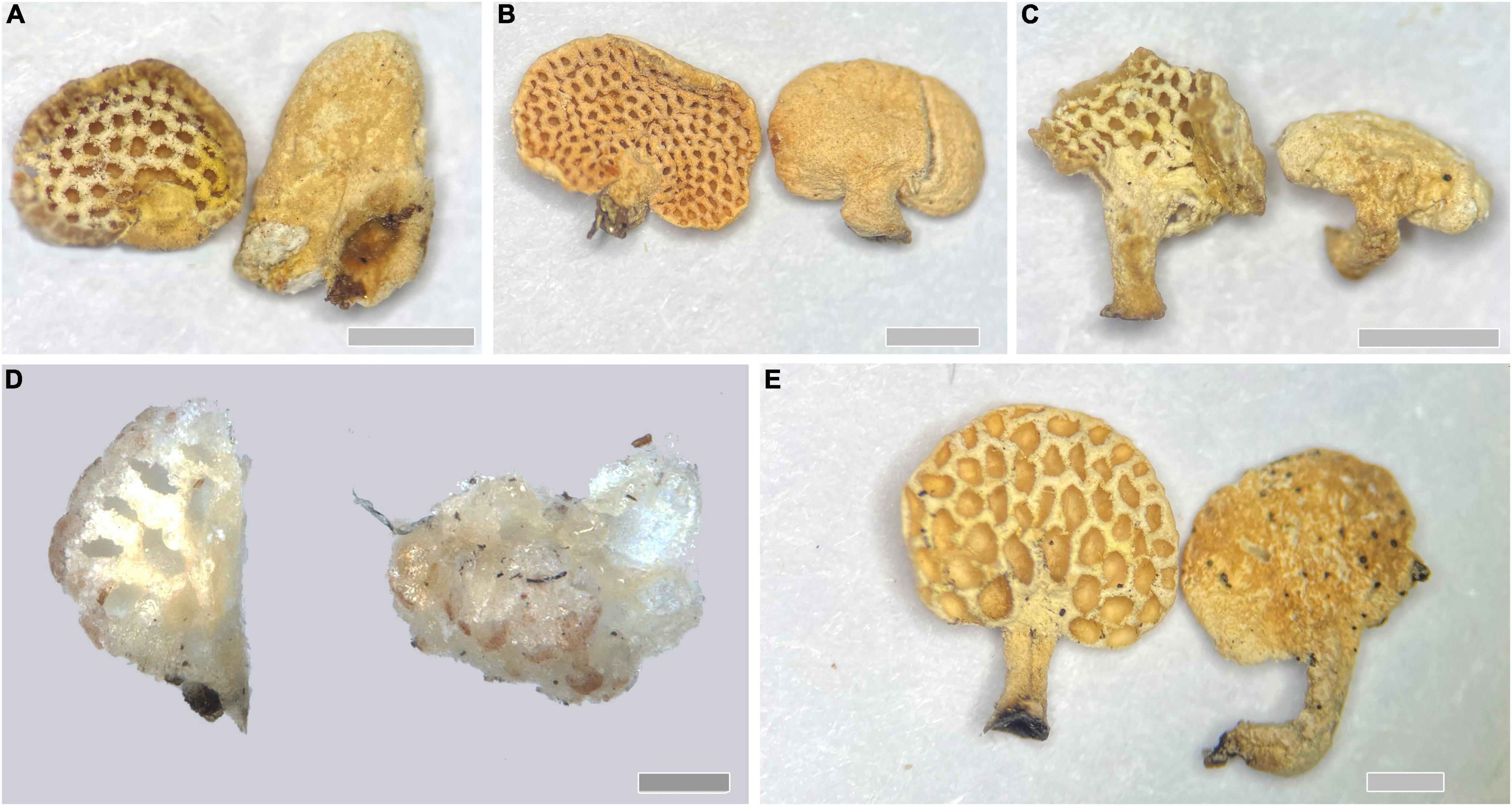
Figure 3. Basidiocarps of Panellus species. (A) P. alpinus; (B) P. crassiporus; (C) P. longistipitatus; (D) P. minutissimus; (E) P. palmicola [Scale bars: (A–C,E) = 1 mm; (D) = 0.2 mm].
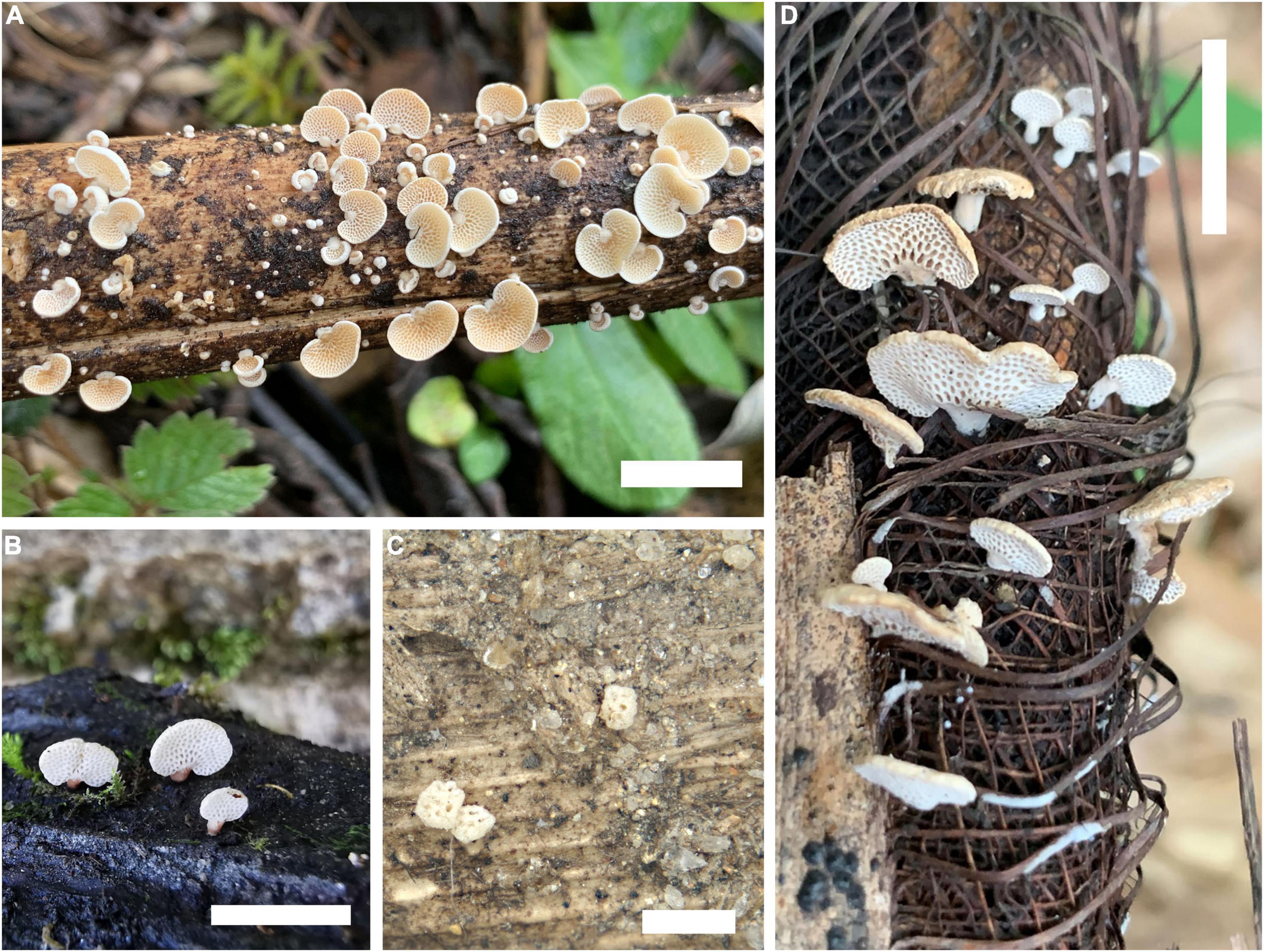
Figure 4. In situ photo documentations of Panellus species. (A) P. alpinus (holotype); (B) P. crassiporus (Dai 23663); (C) P. minutissimus (holotype); (D) P. palmicola (Dai 22334) [Scale bars: (A,B,D) = 5 mm; (C) = 1 mm].
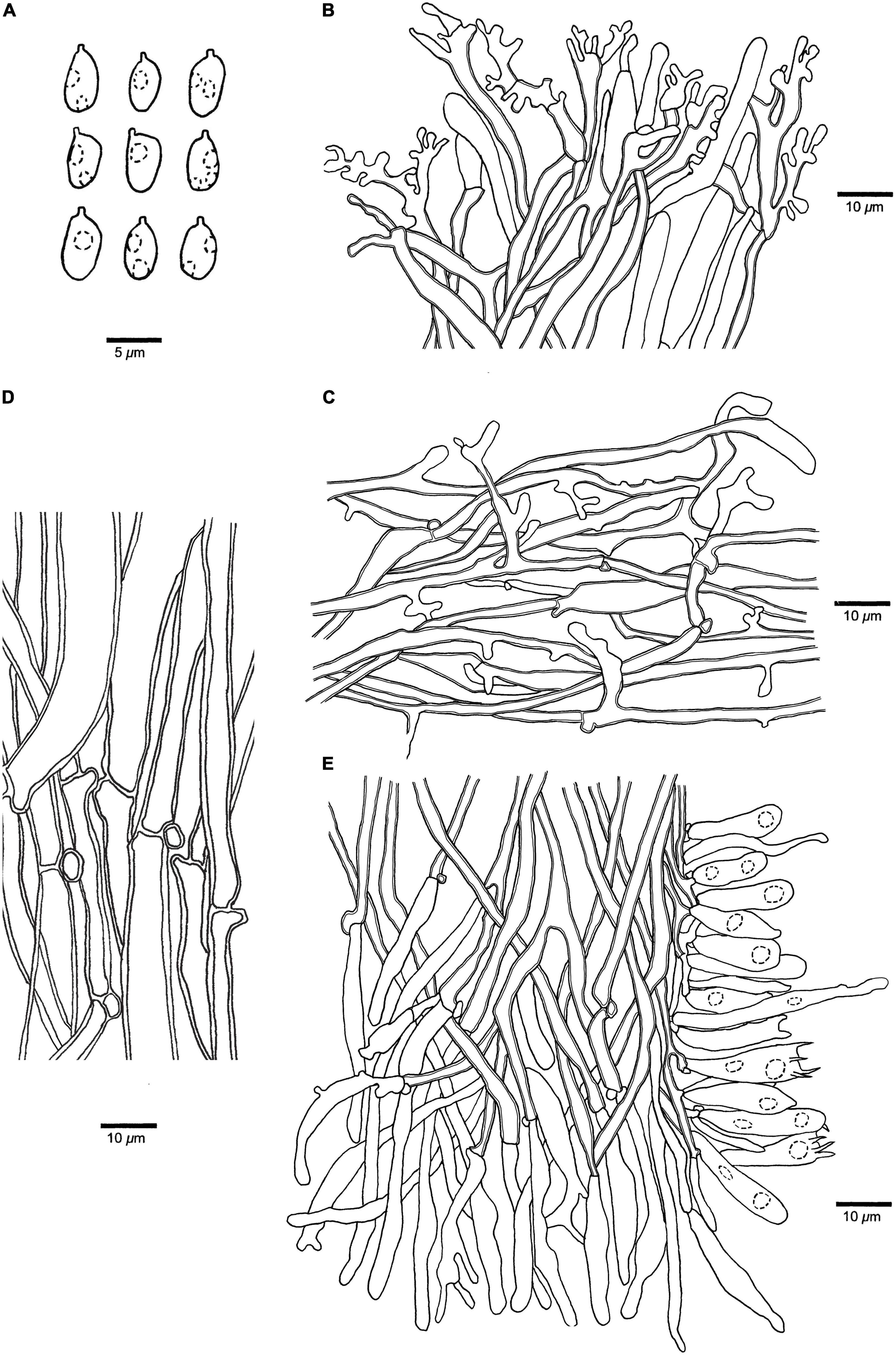
Figure 5. Microscopic structures of Panellus alpinus (holotype). (A) Basidiospores. (B) Dichophysial hyphae and pileocystidia from pileipellis. (C) Hyphae from pileus. (D) Hyphae from stipe base. (E) A section of tube trama, including pleurocystidia, cheilocystidia, basidia, and basidioles. The dotted circles represent some guttules in basidiospores, basidia or basidioles.
MycoBank: MB844364.
Type. China, Tibet Autonomous Region, Nyingchi, Bomi County, dead bamboo (Bambusoideae), 26 October 2021, Dai 23600 (holotype, BJFC 038172).
Etymology. Alpinus (Lat.): Referring to the species being found in high-altitude areas.
Basidiocarps annual, pileate with a lateral rudimentary stipe base, gregarious, soft corky when fresh, and chalky when dry. Pileus 1.5–4 mm × 1–3 mm, flabelliform, semicircular or ellipsoid; pileal surface white to cream when fresh and dry, opaque, convex to plane, pruinose; margin incurved, entire; context thin. Hymenophore concolorous with pileal surface, poroid, about 80–150 pores per basidiocarp; mature pores 4–6 per mm, round or elongated to ellipsoid; tubes up to 0.2 mm long. Stipe base 0.4–1 mm × 0.2–0.6 mm, concolorous with pileal surface, tapering to the slightly swollen base, and pruinose on surface.
Basidiospores (4.5–)4.8–6(–6.5) μm × (2.7–)2.8–3.6 μm, L = 5.29 μm, W = 3.07 μm, Q = 1.70–1.76 (n = 90/3), oblong ellipsoid, tapering at apiculus, hyaline, thin-walled, smooth, with some guttules, faintly IKI+, CB–. Basidia 17–24 μm × 4–6 μm, clavate with some guttules, 4–spored, sterigmata 2–4 μm long; basidioles 16–24 μm × 4–5 μm, clavate to acerose. Pleurocystidia 20–36 μm × 3–4 μm, present in hymenium, narrowly clavate or apiculate, thin-walled. Cheilocystidia 25–45 μm × 2–5 μm, present at dissepiment edge, subulate to long fusiform, thin-walled, some with diverticulate projections at the apex. Pileipellis comprises a palisade of abundant dichophysial hyphae and pileocystidia; dichophysial hyphae slightly thick-walled, 2–4 μm in diameter; pileocystidia 22–47 μm × 3–5 μm, narrowly clavate, thin-walled, some with diverticulate projections, and sometimes indistinguishable from the dichophysial hyphae. Pileus hyphae interwoven, with diverticulate projections, slightly thick-walled, 1.5–5 μm in diameter. Tramal hyphae interwoven, occasionally branched, slightly thick-walled, 2–4 μm in diameter. Hyphae in stipe base subparallel along stipe, some part swollen, slightly thick-walled, 3–12 μm in diameter. Clamp connections are present.
Additional specimens (paratypes) examined: CHINA, Tibet Autonomous Region, Nyingchi, Bomi County, dead bamboo (Bambusoideae), 26 October 2021, Dai 23597 (BJFC 038169), Dai 23598 (BJFC 038170), Dai 23599 (BJFC 038171), Dai 23601 (BJFC 038173), Dai 23602 (BJFC 038174), Dai 23605 (BJFC 038177).
Note. Panellus alpinus grows on dead bamboo (Bambusoideae), and it was found in Tibet, China at an elevation of 3,000 m around timberline.
Panellus crassiporus Q. Y. Zhang, F. Wu, and Y. C. Dai, sp. nov., Figures 3B, 4B, 6.
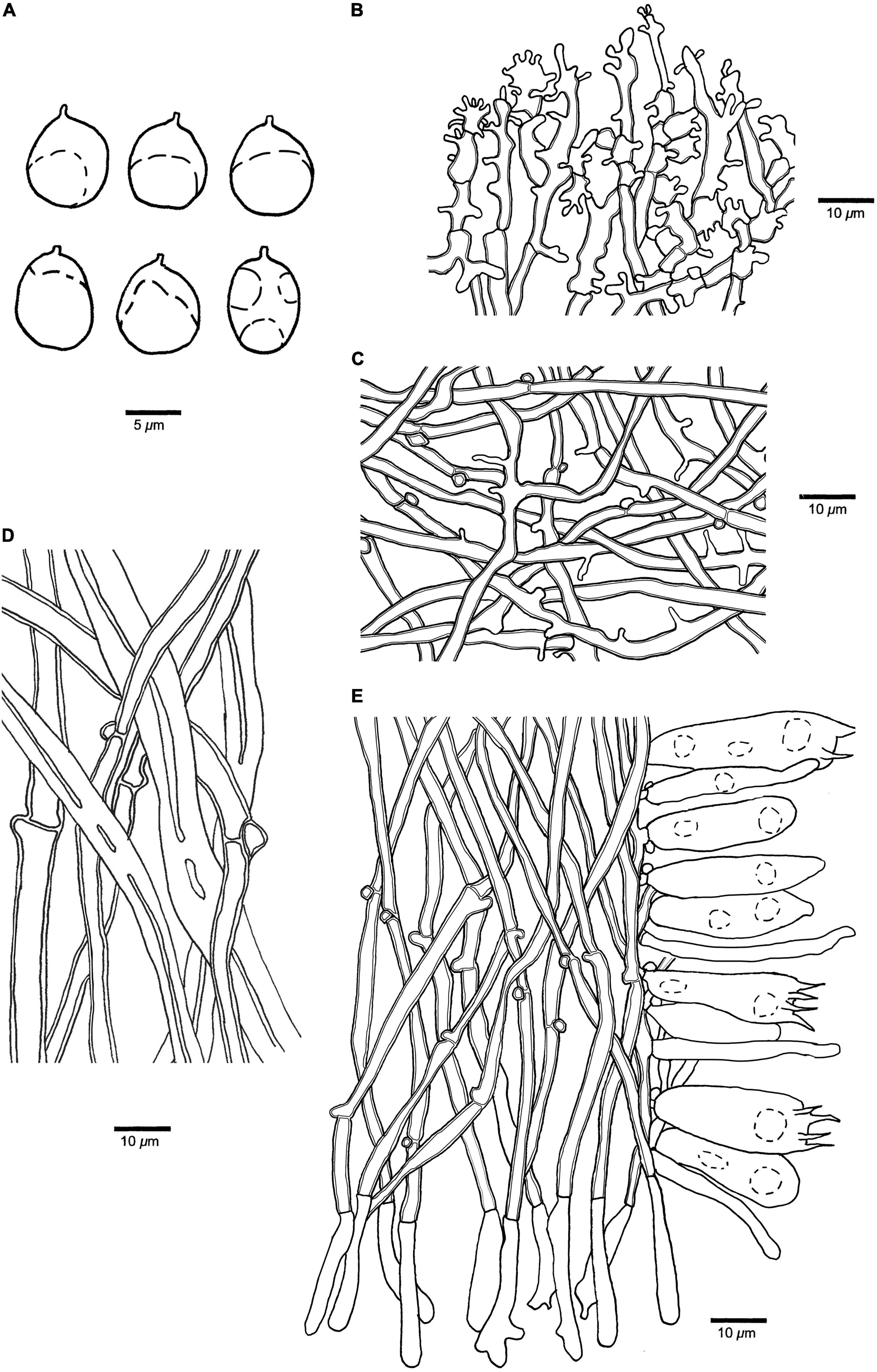
Figure 6. Microscopic structures of Panellus crassiporus (holotype). (A) Basidiospores. (B) Dichophysial hyphae from pileipellis. (C) Hyphae from pileus. (D) Hyphae from stipe. (E) A section of tube trama, including pleurocystidia, cheilocystidia, basidia, and basidioles. The dotted circles represent some guttules in basidiospores, basidia or basidioles.
MycoBank: MB844365.
Type. China, Yunnan Province, Wenshan, Xichou County, Xiaoqiaogou Forest Farm, fallen angiosperm trunk, 29 June 2019, Dai 19963 (holotype, BJFC 031637).
Etymology. Crassiporus (Lat.): referring to the species having thick dissepiments of pores.
Basidiocarps annual, gregarious, soft corky when fresh, and chalky when dry. Pileus 2–5 × 1–3 mm, reniform or flabelliform; pileal surface white to pale buff when fresh and dry, opaque, convex to plane, pruinose; margin incurved or straight, entire; context thin. Hymenophore concolorous with a pileal surface, poroid, about 60–180 pores per basidiocarp; mature pores 4–6 per mm, irregularly angular to round with thick dissepiments; tubes up to 0.4 mm long. Stipe 0.1–1.3 mm × 0.1–0.5 mm, concolorous with a pileal surface, laterally attached, short with slightly swollen base, pruinose on the surface.
Basidiospores (7.5–)8–9.8(–10) μm × (6.8–)6.9–8(–9) μm, L = 8.63 μm, W = 7.52 μm, Q = 1.13–1.16 (n = 90/3), subglobose to globose, hyaline, thin-walled, smooth, with some guttules, faintly IKI+, CB–. Basidia 30–36 μm × 8–12 μm, clavate with some guttules, 2(–4)–spored, sterigmata 2–5 μm long; basidioles 22–34 μm × 5–9 μm, clavate, acerose or fusiform. Pleurocystidia 18–38 μm × 3–7 μm, present in hymenium, tubular, thin-walled. Cheilocystidia 22–30 μm × 3–5 μm, present at dissepiment edge, tubular or narrowly clavate, thin-walled, some with diverticulate projections at the apex. Pileipellis comprises abundant, dense dichophysial hyphae; dichophysial hyphae slightly thick-walled, 3–5 μm in diameter; pileocystidia absent. Pileus hyphae interwoven, with diverticulate projections, slightly thick-walled, 1.5–5 μm in diameter. Tramal hyphae interwoven, slightly thick-walled, 2–4 μm in diameter. Hyphae in stipe subparallel along stipe, some part swollen, thick-walled, 3–9 μm in diameter. Clamp connections present.
Additional specimens (paratypes) examined: China, Tibet Autonomous Region, Nyingchi, Medog County, Guoguotang, rotten angiosperm wood, 28 August 2021, Dai 23663 (BJFC 038235), fallen angiosperm trunk, Dai 23664 (BJFC 038236); Yunnan Province, Wenshan, Xichou County, Xiaoqiaogou Forest Farm, rotten angiosperm wood, 29 June 2019, Dai 19977 (BJFC 031651).
Note. Panellus crassiporus was found in Medog (elevation around 1000 m) of Tibet and Xichou of Yunnan, southwest China, and both areas have subtropical vegetation.
Panellus longistipitatus Q. Y. Zhang, F. Wu, and Y. C. Dai, sp. nov., Figures 3C, 7.
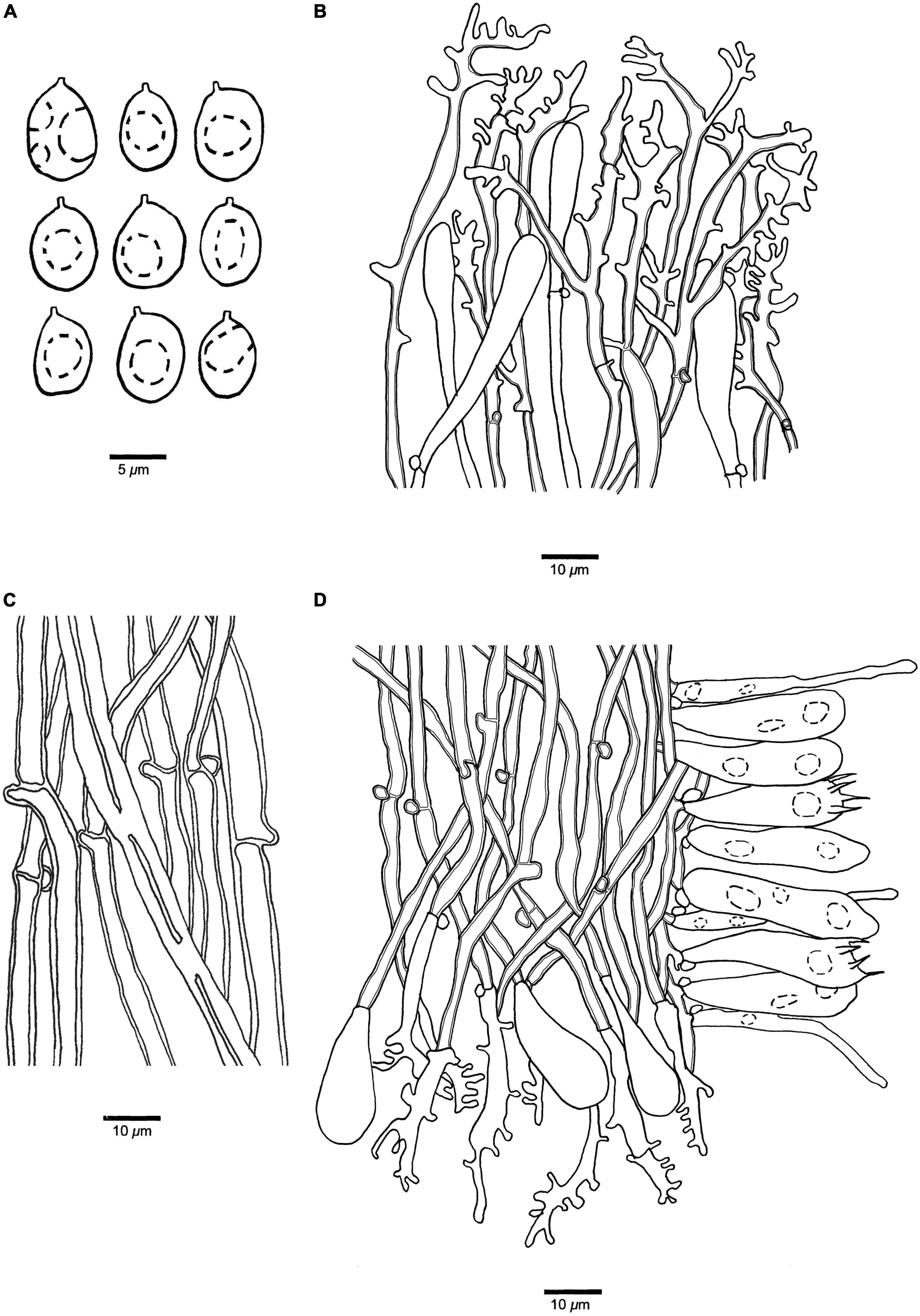
Figure 7. Microscopic structures of Panellus longistipitatus (holotype). (A) Basidiospores. (B) Dichophysial hyphae and pileocystidia from pileipellis. (C) Hyphae from stipe. (D) A section of tube trama, including pleurocystidia, cheilocystidia, basidia, and basidioles. The dotted circles represent some guttules in basidiospores, basidia or basidioles.
MycoBank: MB844366.
Type. Hainan Province, Qiongzhong County, Hainan Tropical Rainforest National Park, Limushan, dead Trachycarpus fortunei, 29 June 2021, Dai 22487 (holotype, BJFC 037070).
Etymology. Longistipitatus (Lat.): referring to the species having a long stipe.
Basidiocarps annual, gregarious, soft corky when fresh, and chalky when dry. Pileus 1–4.2 × 1–3 mm, reniform to semicircular; pileal surface white to cream when fresh and dry, opaque, convex to plane, pruinose; margin incurved, entire; context thin. Hymenophore concolorous with pileal surface, poroid, about 42–164 pores per basidiocarp; mature pores 4–6 per mm, round to irregularly angular; tubes up to 0.3 mm long. Stipe 1–3 mm × 0.8–1 mm, concolorous with pileal surface, laterally attached, somewhat reduce to a tapering base, pruinose on surface.
Basidiospores 7–9.8(–10) μm × 5–7 μm, L = 8.03 μm, W = 6.27 μm, Q = 1.32–1.33 (n = 60/2), broadly ellipsoid to subglobose, hyaline, thin-walled, smooth, with some guttules, faintly IKI+, CB–. Basidia 28–36 μm × 5–8 μm, clavate with some guttules, 4–spored, sterigmata 3–6 μm long; basidioles 23–31 μm × 6–9 μm, clavate to acerose. Pleurocystidia 35–53 μm × 3–6 μm, present in hymenium, tubular with tapered at the apex, thin-walled. Cheilocystidia 15–28 μm × 7–11 μm, present at dissepiment edge, pyriform, thin-walled. Pileipellis comprises a palisade of numerous dichophysial hyphae and pileocystidia; dichophysial hyphae slightly thick-walled, 2–5 μm in diameter; pileocystidia 17–40 μm × 5–8 μm, narrowly clavate, thin-walled. Tramal hyphae subparallel along tubes, slightly thick-walled, 3–5 μm in diameter; numerous dichophysial hyphae present at dissepiment edge. Hyphae in stipe subparallel along stipe, thick-walled, 3–7 μm in diameter. Clamp connections present.
Additional specimen (paratype) examined: China, Hainan Province, Qiongzhong County, Hainan Tropical Rainforest National Park, Limushan, dead Trachycarpus fortune, 11 November 2020, Dai 22065 (BJFC 035958).
Note. Panellus longistipitatus grows on dead palm (Trachycarpus fortune) in a tropical forest.
Panellus minutissimus Q. Y. Zhang, F. Wu, and Y. C. Dai, sp. nov., Figures 3D, 4C, 8.
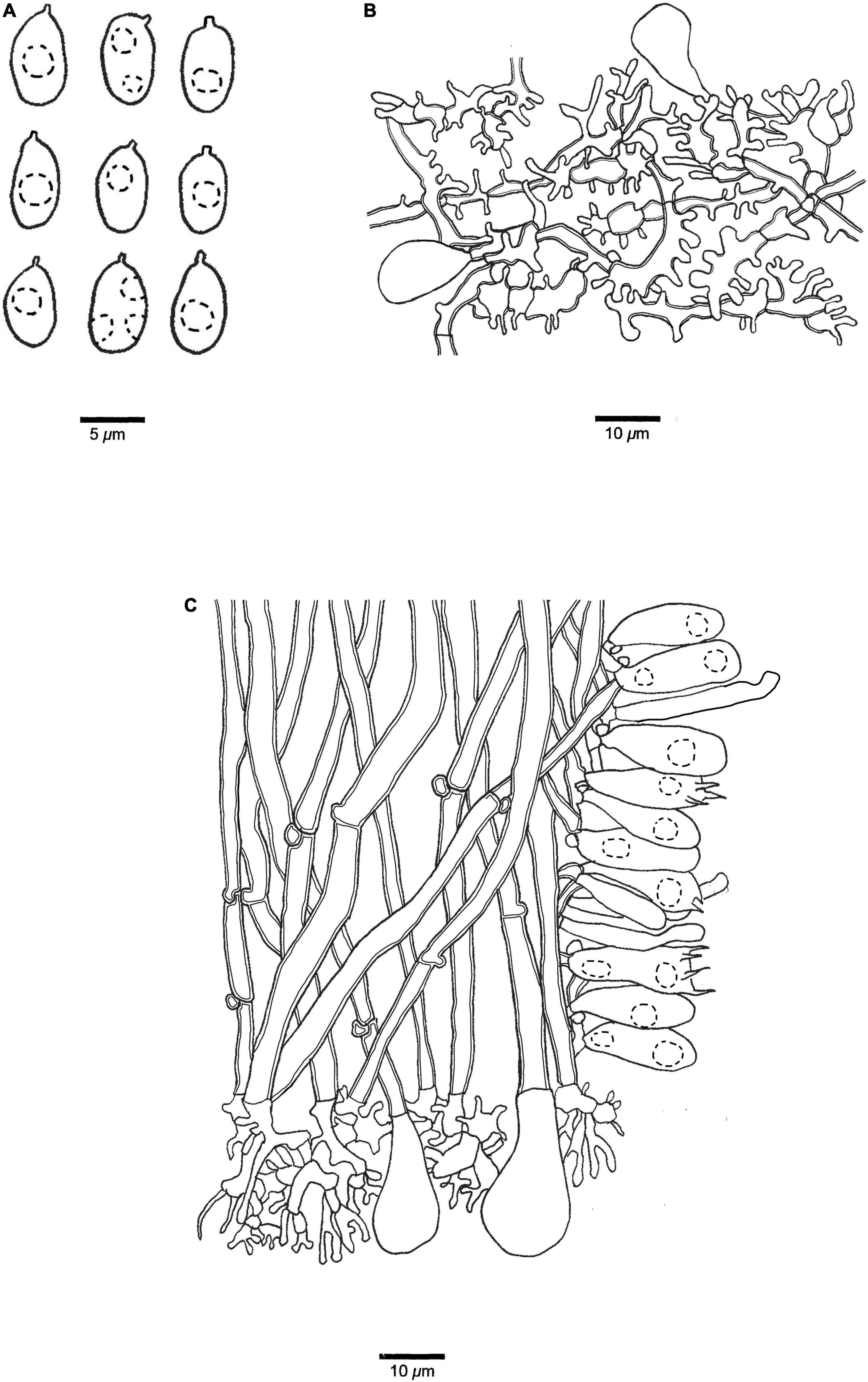
Figure 8. Microscopic structures of Panellus minutissimus (holotype). (A) Basidiospores. (B) Dichophysial hyphae and pileocystidia from pileipellis. (C) A section of tube trama, including pleurocystidia, cheilocystidia, basidia, and basidioles. The dotted circles represent some guttules in basidiospores, basidia or basidioles.
MycoBank: MB844367.
Type. Hainan Province, Qiongzhong County, Hainan Tropical Rainforest National Park, Limushan, dead bamboo (Bambusoideae), 11 November 2020, Dai 22052 (holotype, BJFC 035946).
Etymology. Minutissimus (Lat.): referring to the species having tiny basidiocarps.
Basidiocarps annual, gregarious, and gelatinous. Pileus 0.2–0.6 mm × 0.1–0.6 mm, conchoid, semicircular or ellipsoid; pileal surface pure white to white when fresh, becoming pale cream to ivory upon drying, opaque, convex to plane, slightly powdery appearance; margin incurved; context thin. Hymenophore concolorous with pileal surface, poroid, about 4–15 pores per basidiocarp; mature pores 8–10 per mm, round to ellipsoid. Stipe absent.
Basidiospores 6–8(–8.2) μm × 3.2–4.2(–4.5) μm, L = 6.98 μm, W = 3.90 μm, Q = 1.78–1.79 (n = 60/2), ellipsoid to oblong ellipsoid, tapering at apiculus, hyaline, thin-walled, smooth, with some guttules, faintly IKI+, CB–. Basidia 18–21 μm × 6–8 μm, clavate with some guttules, 4–spored, sterigmata 1–5 μm long; basidioles 14–20 μm × 4–7 μm, clavate or acerose. Pleurocystidia 15–25 μm × 2.5–4 μm, present in hymenium, tubular with slightly curved at the apex, thin-walled. Cheilocystidia 20–24 μm × 10–12 μm, present at dissepiment edge, mostly pyriform, thin-walled. Pileipellis composed of interwoven dichophysial hyphae and pileocystidia; dichophysial hyphae slightly thick-walled, 2–5 μm in diameter; pileocystidia 12–16 μm × 6–9 μm, pyriform, thin-walled. Tramal hyphae subparallel along tubes, slightly thick-walled, 3–6 μm in diameter; numerous dichophysial hyphae present at dissepiment edge, interspersed between cheilocystidia. Clamp connections present.
Additional specimen (paratype) examined: China, Hainan Province, Qiongzhong County, Hainan Tropical Rainforest National Park, Limushan, dead bamboo (Bambusoideae), 11 November 2020, Dai 22068 (BJFC 035961).
Note. Panellus minutissimus is a gelatinous species with a very small pileus, and it grows on small bamboo (Bambusoideae) in a tropical forest.
Panellus palmicola Q. Y. Zhang, F. Wu, and Y. C. Dai, sp. nov., Figures 3E, 4D, 9.
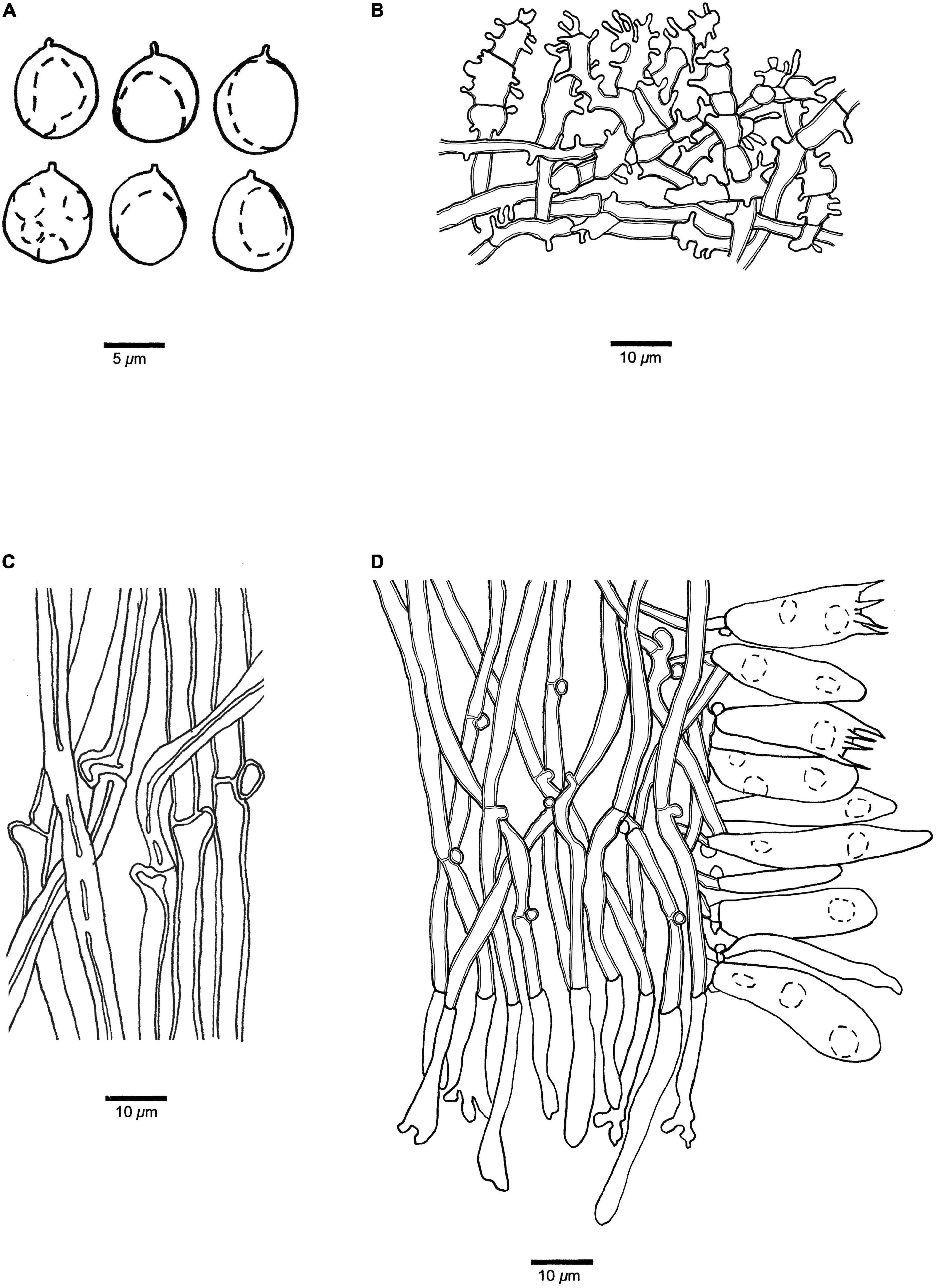
Figure 9. Microscopic structures of Panellus palmicola (holotype). (A) Basidiospores. (B) Dichophysial hyphae from pileipellis. (C) Hyphae from stipe. (D) A section of tube trama, including pleurocystidia, cheilocystidia, basidia, and basidioles. The dotted circles represent some guttules in basidiospores, basidia or basidioles.
MycoBank: MB844368.
Type. Guangdong Province, Guangzhou, Baiyunshan, on Trachycarpus fortune, 11 June 2019, Dai 19717 (holotype, BJFC 031392).
Etymology. Palmicola (Lat.): referring to the species growth on palm (Trachycarpus fortune).
Basidiocarps annual, gregarious, soft corky when fresh, and chalky when dry. Pileus 3–6 mm × 1–3 mm, reniform, flabelliform or ellipsoid; pileal surface cream, pale buff or cinnamon when fresh and dry, opaque, convex to plane, pruinose; margin incurved or straight, entire; context thin. Hymenophore concolorous with pileal surface, poroid, about 40–130 pores per basidiocarp; mature pores 2–4 per mm, round; tubes up to 0.4 mm long. Stipe 1.5–3 mm × 0.5–1 mm, concolorous with pileal surface, laterally attached, subcylindrical, equal in most of the width but with a slightly swollen base, pruinose on the surface.
Basidiospores 7–9.5(–9.8) μm × (6–)6.2–8.2(–8.5) μm, L = 8.33 μm, W = 7.16 μm, Q = 1.15–1.20 (n = 90/3), subglobose to globose, hyaline, thin-walled, smooth, with some guttules, faintly IKI+, CB–. Basidia 28–34 μm × 8–11 μm, clavate with some guttules, 4–spored, sterigmata 3–5 μm long; basidioles 26–32 μm × 6–8 μm, clavate or acerose. Pleurocystidia 20–30 μm × 3–5 μm, present in hymenium, fusiform or tubular, thin-walled. Cheilocystidia 22–40 μm × 3–4.5 μm, present at dissepiment edge, cylindrical or tubular, thin-walled, some with diverticulate projections at the apex. Pileipellis comprises abundant, dense dichophysial hyphae; dichophysial hyphae slightly thick-walled, 2–7 μm in diameter; pileocystidia absent. Tramal hyphae subparallel along tubes, slightly thick-walled, 3–5 μm in diameter. Hyphae in stipe subparallel along stipe, thick-walled, some part swollen, 3–8 μm in diameter. Clamp connections present.
Additional specimens (paratypes) examined: China, Fujian Province, Fuzhou, Fuzhou National Forest Park, living Rhapis excelsa, 4 June 2021, Dai 22329 (BJFC 036917), Dai 22330 (BJFC 036918), Dai 22331 (BJFC 036919), Dai 22332 (BJFC 036920), Dai 22333 (BJFC 036921), Dai 22334 (BJFC 036922), Dai 22335 (BJFC 036923); Guangdong Province, Guangzhou, Baiyunshan, on Trachycarpus fortune, 11 June 2019, Dai 19718 (BJFC 031393), Dai 19719 (BJFC 031394); Zhaoqing, Fengkai County, Heishiding Nature Reserve, angiosperm wood, 7 June 2019, Dai 19707 (BJFC 031382).
Note. Panellus palmicola was found in Fujian and Guangdong, subtropical China, and it grows on both monocotyledonous and dicotyledonous plants in parks.
Discussion
In this study, 15 previously accepted poroid species of Panellus, viz. Panellus albifavolus Corner, P. bambusicola, Panellus bambusifavolus Corner, Panellus brunneifavolus Corner, Panellus hispidifavolus Corner, Panellus luminescens (Corner) Corner, Panellus luxfilamentus A. L. C. Chew and Desjardin, Panellus megalosporus Corner, Panellus microsporus Corner, Panellus minimus (Jungh.) P. R. Johnst. and Moncalvo, Panellus orientalis (Kobayasi) Corner, Panellus pauciporus Corner, P. pusillus, Panellus sublamelliformis Corner, and P. yunnanensis, were identified mostly based on morphological examination. Among them, only four species, viz. Panellus bambusicola, P. minimus, P. pusillus, and P. yunnanensis, were confirmed by molecular evidence. Our present study demonstrates five new poroid species of Panellus based on both morphological characteristics and molecular phylogenetic analyses.
Panellus alpinus was found in Tibet, China, at an altitude of 3,000 m. Phylogenetically, samples of P. alpinus (Dai 23597 and Dai 23601) formed an independent linage and were related to P. pusillus. Morphologically, P. alpinus, P. hispidifavolus, P. luxfilamentus, and P. pusillus share chalky basidiocarps when dry and similar basidiospores (oblong ellipsoid to cylindrical, less than 6 μm in length). However, P. hispidifavolus differs from P. alpinus by the absence of pleurocystidia in hymenium and growth on the dead leaf of Tristania (Corner, 1986). Panellus luxfilamentus is distinguished from P. alpinus by its larger pores (hexagonal, 3 per mm vs. round, 4–6 per mm) and the absence of pleurocystidia in hymenium (Chew et al., 2015).
There are several synonyms for Panellus pusillus in literature (Berkeley, 1839, 1856; Berkeley and Curtis, 1868; Singer, 1953; Corner, 1954; Burdsall and Miller, 1975). Among them, Dictyopanus copelandii Pat. [≡Panellus copelandii (Pat.) Burds. and O. K. Mill.] was described from Philippines (Patouillard, 1914) and Dictyopanus gloeocystidiatus Corner [≡ Panellus gloeocystidiatus (Corner) Corner] was described from Japan (Corner, 1954). Dictyopanus copelandii differs from Panellus alpinus by its longer stipe (4–6 mm vs. 0.4–1 mm in length) and larger basidiospores (6.5–9 μm × 3.5–5.5 μm vs. 4.8–6 μm × 2.8–3.6 μm, Burdsall and Miller, 1975). Dictyopanus gloeocystidiatus is distinguished from Panellus alpinus by its smaller basidiospores (3.2–4 μm × 2–2.3 μm vs. 4.8–6 μm × 2.8–3.6 μm) and thinner basidia (15–19 μm × 3.5–4 μm vs. 17–24 μm × 4–6 μm, Corner, 1954).
Phylogenetically, Panellus minutissimus is closely related to P. bambusicola and P. yunnanensis (Figures 1, 2). However, P. bambusicola differs from P. minutissimus by smaller basidia (15–18 μm × 5–6.5 μm vs. 18–21 μm × 6–8 μm) and the absence of pleurocystidia in hymenium (Zhang and Dai, 2021). Panellus yunnanensis is distinguished from P. minutissimus by its reniform and shell-shaped basidiocarps, longer basidia (20–28 μm × 5–8 μm vs. 18–21 μm × 6–8 μm), and smaller cheilocystidia (10–20 μm × 7–10 μm vs. 20–24 μm × 10–12 μm; Zhang and Dai, 2021). Morphologically, P. albifavolus and P. minimus are similar to P. minutissimus by sharing gelatinous basidiocarps, growth on palm (Trachycarpus fortune), bamboo (Bambusoideae), and other monocotyledons. However, P. albifavolus is distinguished from P. minutissimus by its larger basidiocarps (up to 3 mm vs. 0.2–0.6 mm), wider basidiospores (7–8.5 μm × 4.7–6 μm vs. 6–8 μm × 3.2–4.2 μm), and the absence of pileocystidia (Corner, 1986). Panellus minimus differs from P. minutissimus by its larger basidiocarps (0.9–3.5 mm vs. 0.2–0.6 mm) and long stipe (up to 2 mm; Johnston et al., 2006).
In both nrITS and nrITS + nrLSU + mtSSU + nrSSU + tef1 based phylogenies (Figures 1, 2), samples of Panellus crassiporus, P. longistipitatus, and P. palmicola formed three distinct lineages nested in a subclade, and they are closely related. Morphologically, species in the subclade are characterized by chalky basidiocarps when dry and similar basidiospores (subglobose to globose, more than 6 μm in width). However, P. longistipitatus is distinguished from P. crassiporus by its longer stipe (1–3 mm vs. 0.1–1.3 mm in length) and the presence of pileocystidia. Panellus palmicola differs from P. crassiporus in having larger pores (2–4 per mm vs. 4–6 per mm) and longer stipe (1.5–3 mm vs. 0.1–1.3 mm in length). Panellus palmicola differs from P. longistipitatus by its larger pores (2–4 per mm vs. 4–6 per mm), smaller pleurocystidia (20–30 μm × 3–5 μm vs. 35–53 μm × 3–6 μm), and the absence of pileocystidia in hymenium. Furthermore, P. brunneifavolus, P. megalosporus, and P. orientalis have globose basidiospores (Kobayasi, 1963; Corner, 1986). However, P. brunneifavolus and P. megalosporus have big basidiospores measuring 9–12.5 μm × 8–11 μm and 13–18.5 μm × 12–16 μm, respectively, while the basidiospores are 7–9.8 μm × 5–8.2 μm in the three new species. Panellus orientalis is distinguished from P. crassiporus, P. longistipitatus, and P. palmicola by its larger basidiocarps (up to 17 mm vs. 1–6 mm in the three new species) and longer cheilocystidia (40–190 μm × 3–6 μm vs. 15–40 μm × 3–11 μm in the three new species).
Previously, Panellus was characterized by allantoid to narrowly elliptical, amyloid basidiospores, thick-walled tramal hyphae, the presence of cheilocystidia, and lignicolous habitat (Burdsall and Miller, 1975). However, the diversity of poroid Panellus was underestimated. The definition of Panellus has been improved with the discovery of poroid species with globose basidiospores (Kobayasi, 1963; Corner, 1986). Our investigations on the Chinese Panellus show that most species have globose basidiospores. In addition, most Panellus species were found in lowland areas or areas at an elevation below 2,000 m (Corner, 1986; Chang, 1996), while our new species P. alpinus was found in the mountainous area and at an elevation up to 3,000 m. Accordingly, we presume that more new poroid species of Panellus exist in the world, and more species will be confirmed after morphological and molecular analyses.
The main morphological characteristics of 20 poroid species of Panellus are listed in Supplementary Table 1, and an identification key is provided as follows:
1. Basidiospores mostly >6 μm in width, subglobose to globose……………………………………………………………………………………..2
1. Basidiospores mostly <6 μm in width, ellipsoid to cylindrical………………………………………………………………………………….7
2. Pileus up to 17 mm in the largest dimension………………………………………………………………………………0.3
2. Pileus up to 6 mm in the largest dimension………………………………………………………………………………0.4
3. Basidiospores 12–16 μm in width…………………………………………………………………..P. megalosporus
3. Basidiospores 6–8.5 μm in width…………………………………………………………………………P. orientalis
4. Basidiospores mostly >9 μm in width; pleurocystidia absent……………………………………………………………….P. brunneifavolus
4. Basidiospores mostly <9 μm in width; pleurocystidia present……………………………………………………………………………………0.5
5. Pores 2–4 per mm……………………………………………P. palmicola
5. Pores 4–6 per mm………………………………………………………….0.6
6. Stipe up to 3 mm in length; cheilocystidia pyriform……………………………………………………………P. longistipitatus
6. Stipe up to 1.3 mm in length; cheilocystidia tubular or narrowly clavate……………………………………………………………………P. crassiporus
7. Basidiospores mostly >6 μm in length……………………………………………………………………………………0.8
7. Basidiospores mostly <6 μm in length……………………………………………………………………………………16
8. Basidiocarps subgelatinous to gelatinous when dry……………………………………………………………………………………0.9
8. Basidiocarps chalky when dry……………………………………………………………………………………0.14
9. Pileus up to 3 mm in the largest dimension……………………………………………………………………………0.10
9. Pileus up to 1.5 mm in the largest dimension……………………………………………………………………………0.12
10. Stipe absent…………………………………………………………………..P. albifavolus
10. Stipe present……………………………………………………………….0.11
11. Pileus spherical to elliptical; pores 3–5 per mm…………………………………………………………………………..P. minimus
11. Pileus reniform; pores 5–7 per mm…………………………………………………………………P. bambusifavolus
12. Stipe present……………………………………………..P. bambusicola
12. Stipe absent………………………………………………………………..13
13. Pores 6–7 per mm; pleurocystidia absent…………………………………………………………………P. yunnanensis
13. Pores 8–10 per mm; pleurocystidia present……………………………………………………………….P. minutissimus
14. Basidiospores mostly >9 μm in length…………………………………………………………………..P. luminescens
14. Basidiospores mostly <9 μm in length……………………………………………………………………………………15
15. Pores 10 per mm; cheilocystidia absent……………………………………………………………………P. pauciporus
15. Pores 6 per mm; cheilocystidia present…………………………………………………………..P. sublamelliformis
16. Basidiospores mostly <1 μm in width…………………………………………………………………….P. microsporus
16. Basidiospores mostly >1 μm in width……………………………………………………………………………………..0.17
17. Pleurocystidia and pileocystidia presentP. alpinus
17. Pleurocystidia or pileocystidia absent……………………………………………………………………………………0.18
18. Pores 5–7 per mm………………………………………P. hispidifavolus
18. Pores <5 per mm…………………………………………………19
19. Pileus 2.5–5 mm……………………………………….P. luxfilamentus
19. Pileus 5–20 mm………………………………………………..P. pusillus
Data Availability Statement
The datasets presented in this study can be found in online repositories. The names of the repository/repositories and accession number(s) can be found in the article/Supplementary Material.
Author Contributions
Q-YZ, FW, and Y-CD designed the research and contributed to data analysis and interpretation. Q-YZ and MZ prepared the samples and drafted the manuscript. VP discussed the results and edited the manuscript. All authors contributed to the article and approved the submitted version.
Funding
This research was supported by the Second Tibetan Plateau Scientific Expedition and Research Program (STEP Grant No. 2019QZKK0503) and National Natural Science Foundation of China (Project No. U1802231).
Conflict of Interest
The authors declare that the research was conducted in the absence of any commercial or financial relationships that could be construed as a potential conflict of interest.
The handling editor declared a past collaboration with one of the author VP.
Publisher’s Note
All claims expressed in this article are solely those of the authors and do not necessarily represent those of their affiliated organizations, or those of the publisher, the editors and the reviewers. Any product that may be evaluated in this article, or claim that may be made by its manufacturer, is not guaranteed or endorsed by the publisher.
Acknowledgments
The support of the János Bolyai Research Scholarship of the Hungarian Academy of Sciences to VP is highly appreciated.
Supplementary Material
The Supplementary Material for this article can be found online at: https://www.frontiersin.org/articles/10.3389/fmicb.2022.928941/full#supplementary-material
References
Berkeley, M. J. (1839). Contributions towards a flora of Van Diemen’s Land. J. Nat. Hist. 3, 322–327. doi: 10.1080/03745483909443244
Berkeley, M. J. (1856). Decades of fungi. decades LXI–LXII. rio negro fungi. Hookers J.Bot. Kew Gard. Misc. 8, 272–280.
Berkeley, M. J., and Curtis, M. A. (1868). Fungi cubenses (Hymenomycetes). Bot. J. Linn. Soc. 10, 280–320. doi: 10.1111/j.1095-8339.1868
Burdsall, H. H., and Miller, O. K. (1975). A revaluation of Panellus and Dictyopanus (Agaricales). Nova Hedwig. 51, 79–91.
Burdsall, H. H., and Miller, O. K. (1978). Notes on the genus Panellus (Fungi). Mycotaxon 7, 511–514. doi: 10.1177/014616727800400402
Chang, T. T. (1996). Three poroid Panellus and one Perenniporia species new to Taiwan. Trans. Mycol. Soc. Repub. China 11, 113–120.
Chew, A. L. C., Desjardin, D. E., Tan, Y. S., Musa, M. Y., and Sabaratnam, V. (2015). Bioluminescent fungi from peninsular Malaysia – a taxonomic and phylogenetic overview. Fungal Divers. 70, 149–187. doi: 10.1007/s13225-014-0302-9
Corner, E. J. H. (1954). Further descriptions of luminous agarics. Trans. Br. Mycol. Soc. 37, 256–271. doi: 10.1016/S0007-1536(54)80009-X
Corner, E. J. H. (1986). The agaric genus Panellus Karst. (including Dictyopanus Pat.) in Malaysia. Gardens’. Bull 39, 103–147.
Cui, B. K., Li, H. J., Ji, X., Zhou, J. L., Song, J., Si, J., et al. (2019). Species diversity, taxonomy and phylogeny of Polyporaceae (Basidiomycota) in China. Fungal Divers. 97, 137–392.
Earle, F. S. (1909). The genera of the North American gill fungi. Bull. N. Y. Bot. Gard. 5:373. doi: 10.1016/j.funbio.2018.08.007
Felsenstein, J. (1985). Confidence intervals on phylogenetics: an approach using bootstrap. Evolution 39, 783–791. doi: 10.2307/2408678
Hall, T. A. (1999). BioEdit: a user-friendly biological sequence alignment editor and analysis program for Windows 95/98/NT. Nucleic Acids Symp. Ser. 41, 95–98.
Hillis, D. M., and Bull, J. J. (1993). An empirical test of bootstrapping as a method for assessing confidence in phylogenetic analysis. Syst. Biodivers. 42, 182–192. doi: 10.1093/sysbio/42.2.182
Johnston, P. R., Whitton, S. R., Buchanan, P. K., Park, D., and Moncalvo, J. M. (2006). The basidiomycete genus Favolaschia in New Zealand. N. Z. J. Bot. 44, 65–87. doi: 10.1080/0028825X.2006.9513007
Karsten, P. A. (1879). Rysslands, Finlands och den Skandinaviska halföns Hattsvampar. Förra Delen: Skifsvampar. Bidrag till Kännendom av Finlands. Nat. Och Folk 32, 1–571.
Kobayasi, Y. (1963). Revision of the genus Dictyopanus with special reference to the Japanese species. Biill. Nat. Sci. Mus. Tokyo 6, 356–364.
Libonati-Barnes, S. D., and Redhead, S. A. (1984). Panellus longinquus subsp. pacificus, a new west coast North American agaric associated with red alder. Mycotaxon 20, 205–212.
Liu, Z. B., Zhou, M., Yuan, Y., and Dai, Y. C. (2021). Global diversity and taxonomy of Sidera (Hymenochaetales, Basidiomycota): four new species and keys to species of the genus. J. Fungi 7, 251. doi: 10.3390/jof7040251
Macrae, R. (1937). Interfertility phenomena of the American and European forms of Panus stypticus (Bull.) Fries. Nature 139:674. doi: 10.1038/139674b0
Page, R. D. M. (1996). Treeview: application to display phylogenetic trees on personal computers. Comput. Appl. Biosci. 12, 357–358. doi: 10.1093/bioinformatics/12.4.357
Petersen, J. H. (1996). Farvekort. The Danish Mycological Society’s Color-Chart. Greve: Foreningen til Svampekundskabens Fremme.
Ronquist, F., and Huelsenbeck, J. P. (2003). MrBayes 3: bayesian phylogenetic inference under mixed models. Bioinformatics 19, 1572–1574. doi: 10.1093/bioinformatics/btg180
Royal Botanic Garden Edinburgh (1969). Flora of British Fungi: Colour Identification Chart. Edinburgh: Her Majesty’s Stationery Office.
Stamatakis, A. (2006). RAxML-VI-HPC: maximum likelihood-based phylogenetic analyses with thousands of taxa and mixed models. Bioinformatics 22, 2688–2690. doi: 10.1093/bioinformatics/btl446
Sun, Y. F., Costa-Rezende, D. H., Xing, J. H., Zhou, J. L., Zhang, B., Gibertoni, T. B., et al. (2020). Multi-gene phylogeny and taxonomy of Amauroderma s.lat. (Ganodermataceae). Persoonia 44, 206–239. doi: 10.3767/persoonia.2020.44.08
Swofford, D. L. (2002). PAUP*: Phylogenetic Analysis Using Parsimony (*and other Methods), Version 4.0 Beta. Sunderland, MA: Sinauer. doi: 10.1002/0471650129.dob0522
Thompson, J. D., Gibson, T. J., Plewniak, F., Jeanmougin, F., and Higgins, D. G. (1997). The CLUSTAL X windows interface: flexible strategies for multiple sequence alignment aided by quality analysis tools. Nucleic Acids Res. 25, 4876–4882. doi: 10.1093/nar/25.24.4876
Vilgalys, R., and Hester, M. (1990). Rapid genetic identification and mapping of enzymatically amplified ribosomal DNA from several Cryptococcus species. J. Bacteriol. 172, 4238–4246. doi: 10.1128/jb.172.8.4238-4246.1990
Vu, D., Groenewald, M., De, V. M., Gehrmann, T., Stielow, B., Eberhardt, U., et al. (2018). Large-scale generation and analysis of filamentous fungal DNA barcodes boosts coverage for kingdom fungi and reveals thresholds for fungal species and higher taxon delimitation. Stud. Mycol. 92, 135–154. doi: 10.1016/j.simyco.2018.05.001
Wang, C. G., Josef, V., and Dai, Y. C. (2021). Phylogeny and diversity of Bjerkandera (Polyporales. Basidiomycota), including four new species from South America and Asia. MycoKeys 79, 149–172. doi: 10.3897/mycokeys.79.63908
White, T. J., Bruns, T., Lee, S., and Taylor, J. (1990). “Amplification and direct sequencing of fungal ribosomal RNA genes for phylogenetics,” in PCR Protocols: A Guide to Methods and Applications, eds M. A. Innis, D. H. Gelfand, J. J. Sninsky, and T. J. White (New York, NY: Academic Press), 315–322. doi: 10.1016/B978-0-12-372180-8.50042-1
Wijayawardene, N. N., Hyde, K. D., Dai, D. Q., Sánchez-García, M., Goto, B. T., and Saxena, R. K. (2022). Outline of fungi and fungus-like taxa – 2021. Mycosphere 13, 53–453. doi: 10.5943/mycosphere/13/1/2
Zhang, Q. Y., and Dai, Y. C. (2021). Two new species of Panellus (Agaricales, Basidiomycota) from China. Mycol. Prog. 20, 51–60.
Keywords: Agaricomycetes, Basidiomycota, new taxa, polypore, wood-decaying fungi
Citation: Zhang Q-Y, Liu H-G, Papp V, Zhou M, Wu F and Dai Y-C (2022) Taxonomy and Multi-Gene Phylogeny of Poroid Panellus (Mycenaceae, Agaricales) With the Description of Five New Species From China. Front. Microbiol. 13:928941. doi: 10.3389/fmicb.2022.928941
Received: 26 April 2022; Accepted: 08 June 2022;
Published: 27 July 2022.
Edited by:
Bálint Dima, Eötvös Loránd University, HungaryReviewed by:
Yusufjon Gafforov, Academy of Sciences of the Republic of Uzbekistan, UzbekistanHai-Sheng Yuan, Institute of Applied Ecology (CAS), China
Copyright © 2022 Zhang, Liu, Papp, Zhou, Wu and Dai. This is an open-access article distributed under the terms of the Creative Commons Attribution License (CC BY). The use, distribution or reproduction in other forums is permitted, provided the original author(s) and the copyright owner(s) are credited and that the original publication in this journal is cited, in accordance with accepted academic practice. No use, distribution or reproduction is permitted which does not comply with these terms.
*Correspondence: Fang Wu, ZmFuZ3d1YmpmdTIwMTRAYmpmdS5lZHUuY24=; Yu-Cheng Dai, eXVjaGVuZ2RhaUBiamZ1LmVkdS5jbg==
 Qiu-Yue Zhang
Qiu-Yue Zhang Hong-Gao Liu
Hong-Gao Liu Viktor Papp
Viktor Papp Meng Zhou1
Meng Zhou1 Fang Wu
Fang Wu